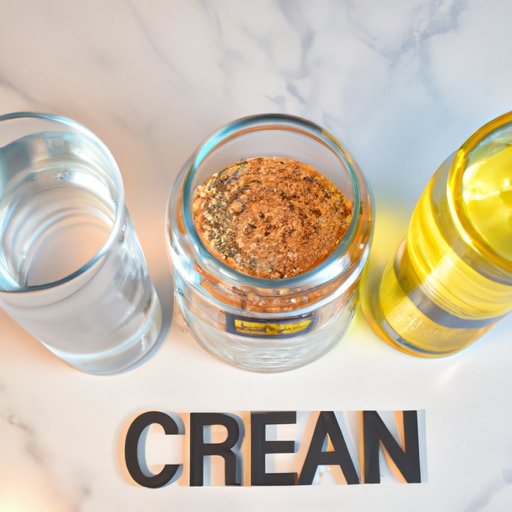
I. Introduction
When a medical condition or procedure requires a patient to go on a clear liquid diet, many people are left wondering what they can and cannot consume. In this article, we will provide you with a list of approved foods and drinks, tips for staying satisfied and full, and ideas for creating your own meals while on the diet. We will also discuss the risks and drawbacks of a prolonged clear liquid diet, as well as how to safely transition back to solid foods.
II. List of Approved Foods and Drinks on a Clear Liquid Diet
First things first, let’s define what can be considered a ‘clear’ liquid. Clear liquids are defined as those that are transparent and do not have any residue. Approved foods and drinks for a clear liquid diet include:
Beverages:
- Water
- Clear broths (chicken, beef, or vegetable broth)
- Tea
- Coffee (without cream or milk)
- Sports drinks
- Clear fruit juices without pulp (apple, cranberry, grape)
Foods:
While the options for clear liquid foods are limited, there are still a few options to choose from:
- Gelatin (without any fruit or toppings)
- Ice pops (without any fruit or cream)
- Honey
- Sugar
- Plain hard candies (without any fillings or coatings)
III. Sample Meal Plan Ideas for Breakfast, Lunch, and Dinner
Creating meal plans while on a clear liquid diet can be challenging. Here are some sample meal plan ideas to help you get started:
Breakfast:
- Clear broth or tea
- Gelatin
- Apple juice
Lunch:
- Chicken broth
- Ice pops
- Ginger ale
Dinner:
- Clear vegetable broth
- Fruit juice
- Ice pops
IV. Tips and Tricks for Staying Full and Satisfied While on a Clear Liquid Diet
Feeling full and satisfied can be a challenge while on a clear liquid diet. Here are some tips to help:
- Drink plenty of fluids throughout the day to keep your stomach full
- Sip your clear liquids slowly and frequently instead of gulping them down all at once
- Add flavor to your clear liquids with herbs and spices (such as ginger or lemon) or by using flavored ice pops or gelatin
- Keep your mind and body busy to avoid focusing on hunger
V. How to Modify Recipes and Create Your Own Clear Liquid Meals at Home
If you’re feeling adventurous, here are some tips for modifying recipes and creating your own clear liquid meals:
- Make your own clear soups and broths at home by simmering vegetables in water or using a bouillon cube
- Use flavored gelatin to add variety to your diet. Unflavored gelatin can also be used with clear liquids to create your own custom flavors
- Blend fruits and vegetables to make smoothies
- Make your own juices by blending and straining fruits and vegetables
VI. Risks and Drawbacks of Being on a Clear Liquid Diet for an Extended Period of Time
While a clear liquid diet can be helpful for short-term medical conditions or procedures, being on a prolonged clear liquid diet can have negative effects. Here are some risks and drawbacks:
- Nutrient deficiencies: the lack of solid foods on the diet can cause deficiencies in essential nutrients, such as protein, fiber, and vitamins.
- Dehydration: a clear liquid diet can cause dehydration as many foods contain water and other fluids.
- Negative impacts on digestion: The lack of fiber in the diet can cause digestion issues such as constipation.
VII. Transitioning Back to Solid Foods After Completing a Clear Liquid Diet
After completing a clear liquid diet, it’s important to reintroduce solids gradually. Here are some tips:
- Start by introducing simple foods such as toast, crackers, or soup with soft vegetables
- Avoid overindulging by introducing one new food at a time and monitoring your body’s response
- If you experience any symptoms such as nausea or vomiting, go back to clear liquids immediately and consult a physician.
VIII. Conclusion
A clear liquid diet can be challenging, but it’s crucial for certain medical conditions or procedures. By understanding what liquids and foods are approved, creating meal plans, and following our tips and tricks, you can successfully adhere to the diet. It’s important to remember the risks associated with a prolonged clear liquid diet and to gradually reintroduce solids back into your diet. Consult your physician if you are concerned about any symptoms or negative effects related to the diet.




